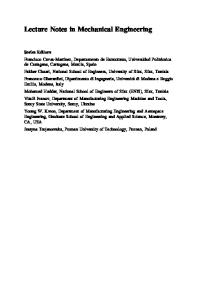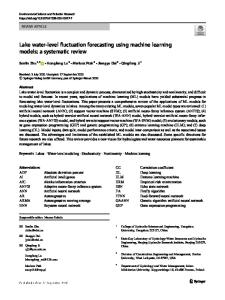Short-term water demand forecasting using hybrid supervised and unsupervised machine learning model
- PDF / 1,669,507 Bytes
- 18 Pages / 595.276 x 793.701 pts Page_size
- 86 Downloads / 397 Views
RESEARCH
Smart Water
Open Access
Short-term water demand forecasting using hybrid supervised and unsupervised machine learning model Mo’tamad Bata1 , Rupp Carriveau1* and David S.-K. Ting2 * Correspondence: rupp@uwindsor. ca 1 Civil and Environmental Engineering Department, Turbulence and Energy Laboratory, Ed Lumley Centre for Engineering Innovation, University of Windsor, 401 Sunset Ave, Windsor, ON, Canada Full list of author information is available at the end of the article
Abstract Regression Tree (RT) forecasting models are widely used in short-term demand forecasting. Likewise, Self-Organizing Maps (SOM) models are known for their ability to cluster and organize unlabeled big data. Herein, a combination of these two Machine Learning (ML) techniques is proposed and compared to a standalone RT and a Seasonal Autoregressive Integrated Moving Average (SARIMA) models, in forecasting the short-term water demand of a municipality. The inclusion of the Unsupervised Machine Learning clustering model has resulted in a significant improvement in the performance of the Supervised Machine Learning forecasting model. The results show that using the output of the SOM clustering model as an input for the RT forecasting model can, on average, double the accuracy of water demand forecasting. The Mean Absolute Percentage Error (MAPE) and the Normalized Root Mean Squared Error (NRMSE) were calculated for the proposed models forecasting 1 h, 8 h, 24 h, and 7 days ahead. The results show that the hybrid models outperformed the standalone RT model, and the broadly used SARIMA model. On average, hybrid models achieved double accuracy in all 4 forecast periodicities. The increase in forecasting accuracy afforded by this hybridized modeling approach is encouraging. In our application, it shows promises for more efficient energy and water management at the water utilities.
Introduction Marching forward toward true sustainability, reliable and resilient water systems are essential in a world facing the challenge of water scarcity. Smart decision making in water systems is one of the two keys a Smart Water consists of (Joong 2018). The application of water demand forecasting is crucial for optimal operation and control of Smart Water Grids (SWG) (Public Utilities Board Singapore 2016). Supplying water at lower cost, with less energy, and lighter load on the network infrastructure is a primary goal of water utilities. This goal is achieved through multiple practices and applications in the water supply system; one of which is an accurate forecast of the systems’ future demand. Short-term water demand forecasting has been employed by a plethora of utilities, researchers, and developers to tackle the imbalance between supply and demand. Short-term water demand forecasting can be used to manage water pressure, © The Author(s). 2020 Open Access This article is licensed under a Creative Commons Attribution 4.0 International License, which permits use, sharing, adaptation, distribution and reproduction in any medium or format, as long as
Data Loading...











